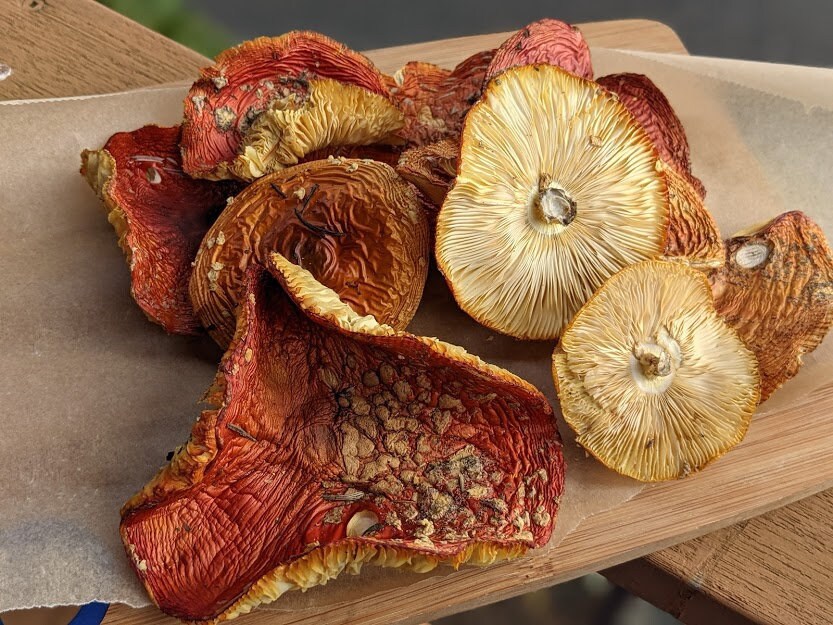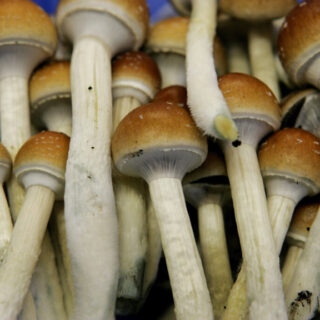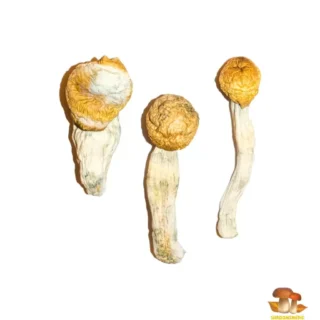- +44 7576018261
- info@psychepharmacy.com
Amanita muscaria
$100.00 – $1,500.00
Buy Amanita Muscaria Online UK
Buy Amanita Muscaria Online UK , Amanita Muscaria for Sale England, order Amanita Muscaria Scotland, Where to buy magic mushroom Northern Ireland
Amanita muscaria, commonly known as the fly agaric or fly amanita, is a basidiomycete of the genus Amanita. It is also a muscimol mushroom. Native throughout the temperate and boreal regions of the Northern Hemisphere, Amanita muscaria has been unintentionally introduced to many countries in the Southern Hemisphere, generally as a symbiont with pine and birch plantations, and is now a true cosmopolitan species. It associates with various deciduous and coniferous trees.
Arguably the most iconic toadstool species, the fly agaric is a large white-gilled, white-spotted, usually red mushroom, and is one of the most recognizable and widely encountered in popular culture, including in video games—e.g., the extensive use of a recognizable Amanita muscaria in the Mario franchise and its Super Mushroom power-up—and television—e.g., the houses in The Smurfs franchise.
Despite its easily distinguishable features, Amanita muscaria is a fungus with several known variations, or subspecies. These subspecies are slightly different, some having yellow or white caps, but they are all usually called fly agarics, and they are most of the time recognizable by their notable white spots. Recent DNA fungi research, however, has shown that some of these variations are not the same species at all, such as the peach-colored fly agaric (Amanita persicina) for example, but the common name ‘fly agaric’ clings on.
Although poisonous, death due to poisoning from A. muscaria ingestion is quite rare. Parboiling twice with water draining weakens its toxicity and breaks down the mushroom’s psychoactive substances; it is eaten in parts of Europe, Asia, and North America. All Amanita muscaria varieties, but in particular A. muscaria var. muscaria, are noted for their hallucinogenic properties, with the main psychoactive constituents being muscimol and its neurotoxic precursor ibotenic acid. A local variety of the mushroom was used as an intoxicant and entheogen by the indigenous peoples of Siberia.Buy Amanita Muscaria Online Minnesota , Amanita Muscaria for Sale Minneapolis, order Amanita Muscaria Saint Paul, Where to buy magic mushroom Duluth
Amanita Muscaria for Sale
The name of the mushroom in many European languages is thought to derive from its use as an insecticide when sprinkled in milk. This practice has been recorded from Germanic- and Slavic-speaking parts of Europe, as well as the Vosges region and pockets elsewhere in France, and Romania.Albertus Magnus was the first to record it in his work De vegetabilibus some time before 1256, commenting vocatur fungus muscarum, eo quod in lacte pulverizatus interficit muscas, “it is called the fly mushroom because it is powdered in milk to kill flies.”
Showing the partial veil under the cap dropping away to form a ring around the stipe
The 16th-century Flemish botanist Carolus Clusius traced the practice of sprinkling it into milk to Frankfurt in Germany,while Carl Linnaeus, the “father of taxonomy”, reported it from Småland in southern Sweden, where he had lived as a child. He described it in volume two of his Species Plantarum in 1753, giving it the name Agaricus muscarius, the specific epithet deriving from Latin musca meaning “fly”. It gained its current name in 1783, when placed in the genus Amanita by Jean-Baptiste Lamarck, a name sanctioned in 1821 by the “father of mycology”, Swedish naturalist Elias Magnus Fries. The starting date for all the mycota had been set by general agreement as January 1, 1821, the date of Fries’s work, and so the full name was then Amanita muscaria (L.:Fr.) Hook. The 1987 edition of the International Code of Botanical Nomenclature changed the rules on the starting date and primary work for names of fungi, and names can now be considered valid as far back as May 1, 1753, the date of publication of Linnaeus’s work.Hence, Linnaeus and Lamarck are now taken as the namers of Amanita muscaria (L.) Lam..Buy Amanita Muscaria Online UK , Amanita Muscaria for Sale England, order Amanita Muscaria Scotland, Where to buy magic mushroom Northern Ireland
The English mycologist John Ramsbottom reported that Amanita muscaria was used for getting rid of bugs in England and Sweden, and bug agaric was an old alternative name for the species.French mycologist Pierre Bulliard reported having tried without success to replicate its fly-killing properties in his work Histoire des plantes vénéneuses et suspectes de la France (1784), and proposed a new binomial name Agaricus pseudo-aurantiacus because of this. One compound isolated from the fungus is 1,3-diolein (1,3-di(cis-9-octadecenoyl)glycerol), which attracts insects. It has been hypothesised that the flies intentionally seek out the fly agaric for its intoxicating properties.An alternative derivation proposes that the term fly- refers not to insects as such but rather the delirium resulting from consumption of the fungus. This is based on the medieval belief that flies could enter a person’s head and cause mental illness.Several regional names appear to be linked with this connotation, meaning the “mad” or “fool’s” version of the highly regarded edible mushroom Amanita caesarea. Hence there is oriol foll “mad oriol” in Catalan, mujolo folo from Toulouse, concourlo fouolo from the Aveyron department in Southern France, ovolo matto from Trentino in Italy. A local dialect name in Fribourg in Switzerland is tsapi de diablhou, which translates as “Devil’s hat”
order Amanita Muscaria
Amanita muscaria is the type species of the genus. By extension, it is also the type species of Amanita subgenus Amanita, as well as section Amanita within this subgenus. Amanita subgenus Amanita includes all Amanita with inamyloid spores. Amanita section Amanita includes the species with patchy universal veil remnants, including a volva that is reduced to a series of concentric rings, and the veil remnants on the cap to a series of patches or warts. Most species in this group also have a bulbous base.Amanita section Amanita consists of A. muscaria and its close relatives, including A. pantherina (the panther cap), A. gemmata, A. farinosa, and A. xanthocephala. Modern fungal taxonomists have classified Amanita muscaria and its allies this way based on gross morphology and spore inamyloidy. Two recent molecular phylogenetic studies have confirmed this classification as natural.
Amanita muscaria var. formosa is now a synonym for Amanita muscaria var. guessowii.
Amanita muscaria varies considerably in its morphology, and many authorities recognize several subspecies or varieties within the species. In The Agaricales in Modern Taxonomy, German mycologist Rolf Singer listed three subspecies, though without description: A. muscaria ssp. muscaria, A. muscaria ssp. americana, and A. muscaria ssp. flavivolvata.Buy Amanita Muscaria Online UK , Amanita Muscaria for Sale England, order Amanita Muscaria Scotland, Where to buy magic mushroom Northern Ireland
However, a 2006 molecular phylogenetic study of different regional populations of A. muscaria by mycologist József Geml and colleagues found three distinct clades within this species representing, roughly, Eurasian, Eurasian “subalpine”, and North American populations. Specimens belonging to all three clades have been found in Alaska; this has led to the hypothesis that this was the centre of diversification for this species. The study also looked at four named varieties of the species: var. alba, var. flavivolvata, var. formosa (including var. guessowii), and var. regalis from both areas. All four varieties were found within both the Eurasian and North American clades, evidence that these morphological forms are polymorphisms rather than distinct subspecies or varieties.Further molecular study by Geml and colleagues published in 2008 show that these three genetic groups, plus a fourth associated with oak–hickory–pine forest in the southeastern United States and two more on Santa Cruz Island in California, are delineated from each other enough genetically to be considered separate species. Thus A. muscaria as it stands currently is, evidently, a species complex.The complex also includes at least three other closely related taxa that are currently regarded as species:[1] A. breckonii is a buff-capped mushroom associated with conifers from the Pacific Northwest,and the brown-capped A. gioiosa and A. heterochroma from the Mediterranean Basin and from Sardinia respectively. Both of these last two are found with Eucalyptus and Cistus trees, and it is unclear whether they are native or introduced from Australia.
Where to buy magic mushroom
A large, conspicuous mushroom, Amanita muscaria is generally common and numerous where it grows, and is often found in groups with basidiocarps in all stages of development. Fly agaric fruiting bodies emerge from the soil looking like white eggs. After emerging from the ground, the cap is covered with numerous small white to yellow pyramid-shaped warts. These are remnants of the universal veil, a membrane that encloses the entire mushroom when it is still very young. Dissecting the mushroom at this stage reveals a characteristic yellowish layer of skin under the veil, which helps identification. As the fungus grows, the red colour appears through the broken veil and the warts become less prominent; they do not change in size, but are reduced relative to the expanding skin area. The cap changes from globose to hemispherical, and finally to plate-like and flat in mature specimens.[33] Fully grown, the bright red cap is usually around 8–20 cm (3–8 in) in diameter, although larger specimens have been found. The red colour may fade after rain and in older mushrooms.Buy Amanita Muscaria Online Minnesota , Amanita Muscaria for Sale Minneapolis, order Amanita Muscaria Saint Paul, Where to buy magic mushroom Duluth
The free gills are white, as is the spore print. The oval spores measure 9–13 by 6.5–9 μm; they do not turn blue with the application of iodine.The stipe is white, 5–20 cm (2–8 in) high by 1–2 cm (1⁄2–1 in) wide, and has the slightly brittle, fibrous texture typical of many large mushrooms. At the base is a bulb that bears universal veil remnants in the form of two to four distinct rings or ruffs. Between the basal universal veil remnants and gills are remnants of the partial veil (which covers the gills during development) in the form of a white ring. It can be quite wide and flaccid with age. There is generally no associated smell other than a mild earthiness.
Although very distinctive in appearance, the fly agaric has been mistaken for other yellow to red mushroom species in the Americas, such as Armillaria cf. mellea and the edible Amanita basii—a Mexican species similar to A. caesarea of Europe. Poison control centres in the U.S. and Canada have become aware that amarill (Spanish for ‘yellow’) is a common name for the A. caesarea-like species in Mexico. Amanita caesarea is distinguished by its entirely orange to red cap, which lacks the numerous white warty spots of the fly agaric. Furthermore, the stem, gills and ring of A. caesarea are bright yellow, not white. The volva is a distinct white bag, not broken into scales. In Australia, the introduced fly agaric may be confused with the native vermilion grisette (Amanita xanthocephala), which grows in association with eucalypts. The latter species generally lacks the white warts of A. muscaria and bears no ring.Buy Amanita Muscaria Online UK , Amanita Muscaria for Sale England, order Amanita Muscaria Scotland, Where to buy magic mushroom Northern Ireland
| Quantity | 1 Oz, 1\4 Lbs, 1/2 Lbs, 1 Lbs |
|---|






Reviews
There are no reviews yet.